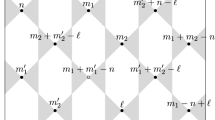Summary
A method of construction of irreducible tensor operators with respect toSU 2⊗SU 2 is discussed. This method permits the unique decomposition of an arbitrary operator into corresponding irreducible tensor operators. It also allows one to derive selection rules if the operator is an irreducible tensor operator with respect to the subgroupSU 2×SU 2≃SU 2. A basis of the operator space ℒ(ℋ’) consisting of irreducible tensor operators with respect toSU 2⊗SU 2 permits a unique alternative decomposition of every operator. This tensor basis (Wigner operators) has the essential property that its elements are uniquely labelled only by parameters needed for the determination of the unitary irreducible representations ofSU 2⊗SU 2. This basis not only suggests certain approximations but also is useful for the definition of new operators (creation and destruction operators).
Riassunto
Si discute un metodo per costruire operatori tensoriali non riducibili rispetto adSU 2◯SU 2. Con questo metodo si ottiene l’unica scomposizione di un operatore arbitrario nei corrispondenti operatori tensoriali non riducibili. Per mezzo di esso si possono anche dedurre regole di selezione se l’operatore è un operatore tensoriale non riducibile rispetto al sottogrouppoSU 2×SU 2≅SU 2. Una base dello spazio degli operatori ℒ(ℋ’) che consiste di operatori tensoriali non riducibili rispetto adSU 2◯SU 2 consente un’unica scomposizione alternativa di ciascun operatore. Questa base tensoriale (operatori di Wigner) ha la proprietà essenziale che i suoi elementi sono unicamente contraddistinti dai parametri necessari per la determinazione della rappresentazione unitaria non riducibile diSU 2◯SU 2. Questa base non solo suggerisce alcune approssimazioni, ma è anche utile per la definizione di nuovi operatori (operatori di creazione e distruzione).
Резюме
Обсуждается метод конструирования неприводимых тензорных операторов по отношению кSU 2◯SU 2. Этот метод допускает единственное разложение произвольного оператора на соответствующие неприводимые тензорные операторы. Этот метод также позволяет получить правияа отбора, если рассматриваемый оператор является неприводимым тензорным оператором по отношению к подгруппеSU 2×SU 2≅SU 2. Базис операторного пространства ℒ(ℋ’), состоящий из неприводимых тензорных операторов по отношению кSU 2◯SU 2, допускает единственное альтернативное разложение любого оператора. Этот тензорный базис (операторы Вигнера) имеет существенное свойство, что его элементы однозначно характеризуются только параметрами, необходимыми для определения унитарных неприводимых представленииSU 2◯SU 2. Этот базис не только подсказывает некоторые приближения, но явияется также удобным для определения новых операторов (операторов пождения и уничтожения).
Similar content being viewed by others
References
E. P. Wigner:Group Theory and Its Applications to the Quantum Mechanics of Atomic Spectra (New York, N. Y., 1959).
J. S. Lomont:Applications of Finite Groups (New York, N. Y., 1959).
L. C. Biedenharn:Group theoretical approaches to nuclear spectroscopy, inW. E. Brittin, B. W. Downs andJ. Downs:Lectures in Theoretical Physics (New York, N. Y., 1963).
L. C. Biedenharn:Phys. Lett.,3, 69 (1963).
L. C. Biedenharn:On Racah coefficients as coupling coefficients for the vector space of Wigner operators, inF. Bloch et al.: Spectroscopic and Group Theoretical Methods in Physics (Amsterdam, 1968).
J. D. Louck andL. C. Biedenharn:Journ. Math. Phys.,11, 2368 (1970).
J. D. Louck andL. C. Biedenhaen:Journ. Math. Phys.,12, 173 (1971).
L. C. Biedenharn, J. D. Louck, E. Chacon andM. Ciftan:Journ. Math. Phys.,13, 1957 (1972).
L. C. Biedenharn andJ. D. Louck:Journ. Math. Phys.,13, 1985 (1972).
L. C. Biedenharn andJ. D. Louck:Journ. Math. Phys.,14, 1336 (1973).
P. Kasperkovitz andR. Dirl:Irreducible tensorial sets within the group algebra of a compact group (to appear inJourn. Math. Phys.).
A. J. van Zanten andE. De-Vries:Journ. Math. Phys.,14, 1423 (1973).
R. Dirl:Nuovo Cimento,23 B, 417 (1974).
R. Dirl andG. Angerer:Nuovo Cimento,13 A, 1065 (1973).
W. H. Stevens:Proc. Phys. Soc.,65 A, 209 (1952).
B. R. Judd:Operator Techniques in Atomic Spectroscopy (New York, N. Y., 1963).
A. O. Barut andH. Kleinert:Phys. Rev.,156, 1546 (1967).
H. Kleinert:Fortschr. Phys.,16, 1 (1968).
R. Hermann:Lie Groups for Physicists (New York, N. Y., 1966).
S. Helgason:Differential Geometry and Symmetric Spaces (New York, N. Y., 1962).
J. Schwinger:On angular momentum, inL. C. Biedenharn andH. van Dam:Quantum Theory of Angular Momentum (New York, N. Y., 1965).
G. Racah:Group theory and spectroscopy, inG. Hohler:Springer Tracts in Modern Physics, Vol.37 (Berlin, 1965), p. 28.
A. J. Coleman:Induced and subduced representations, inM. Loebl:Group Theory and Its Applications, Vol.1 (New York, N. Y., 1968).
M. Hamermesh:Group Theory and Its Applications to Physical Problems (Reading, Mass., 1964).
S. Pasternak andR. M. Sternheimer:Journ. Math. Phys.,3, 1280 (1962).
M. E. Rose:Elementary Theory of Angular Momentum (New York, N. Y., 1957).
F. D. Murnaghan:The Unitary and Rotation Groups (Washington, D. C., 1962).
G. Flamand:Journ. Math. Phys.,7, 1924 (1966).
C. E. Wulfman:Dynamical groups in atomic and molecular physics, inM. Loebl:Group Theory and Its Applications, vol.2 (New York, N. Y., 1971).
E. Madelung:Die mathematischen Hilfsmittel des Physikers (Berlin, 1964).
Author information
Authors and Affiliations
Additional information
Traduzione a cura della Redazione.
переведено редакцией.
Rights and permissions
About this article
Cite this article
Dirl, R. The group ring of the dynamical invariance group of the hydrogen atom.—II. Nuovo Cim B 23, 441–472 (1974). https://doi.org/10.1007/BF02723649
Received:
Published:
Issue Date:
DOI: https://doi.org/10.1007/BF02723649



